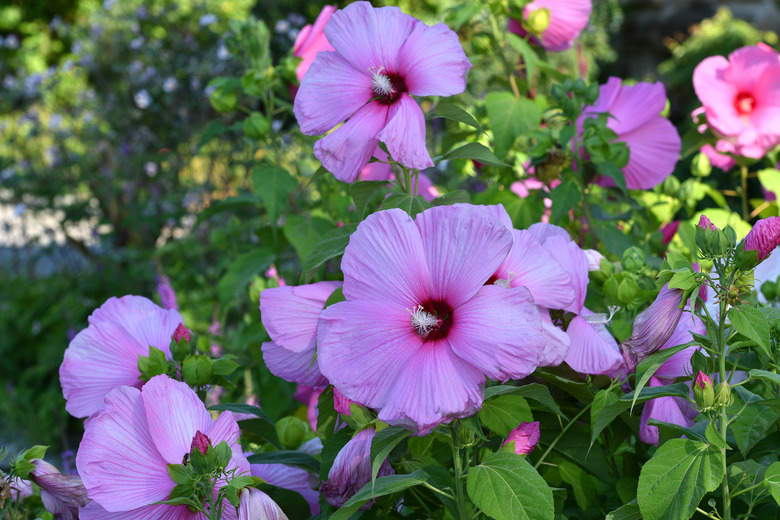How To Get Rid Of Bugs On A Hibiscus Plant
We may receive a commission on purchases made from links.
Hibiscus plants (Hibiscus spp.) are beloved by gardeners for their deep-green foliage and lovely flowers. Unfortunately, they're also a favorite of many insects. Eliminating bugs on a hibiscus plant first requires identifying the invading pest so you can choose the right strategy for that specific type of insect.
Preventing Insect Infestations
Preventing Insect Infestations
The best way to protect your hibiscus from insects is to keep the plant healthy from the start, which could prevent infestations or at the very least keep your plant from suffering serious damage during a pest invasion. Hibiscus plants like a lot of sun, though in warm climates, they don't mind a little shade in the afternoon. Soil should be well drained and high in nutrients, and the plants should be kept far enough away from other greenery to ensure proper air circulation.
Whiteflies and Mealybugs on Hibiscus Plants
Whiteflies and Mealybugs on Hibiscus Plants
Whiteflies, which suck plant sap, and mealybugs, which feed on leaves and stems en masse, can both weaken a hibiscus plant. The real danger of these pests is that they leave behind a sticky substance known as honeydew that attracts ants and frequently supports fungal diseases, like sooty mold. This type of disease can kill plants since it makes it more difficult for the plants to photosynthesize.
Whitefly infestations may appear as white, waxy "spots" on your plant that fly away when the leaves are disturbed. Mealybug infestations typically take the form of masses of a cottony white wax, but you may also notice white insects that do not fly away when disturbed or honeydew on the leaves of your plant.
There are a few ways to manage infestations of whiteflies and mealybugs. Many people like using sticky traps or sticky tape attached to the twigs or stems of plants. These can also catch other insects, such as aphids and thrips, though it's worth noting that these may also trap beneficial insects, such as ladybugs. Sticky tape can also be a good solution to prevent invasions of ants, which are often attracted to the sweet honeydew left behind by whiteflies and mealybugs.
Alternatively, populations of these pests can be reduced with an insecticidal soap sprayed onto the top and bottom sides of the leaves. Spray at dawn or dusk to minimize risk to bees and other pollinators. You may need to reapply it several times a few days apart. In any case, it's unlikely you'll be able to fully eliminate an infestation.
Both whiteflies and mealybugs can also be preyed upon by beneficial insects, such as green lacewings.
Thrips on Hibiscus Plants
Thrips on Hibiscus Plants
Thrips are small black insects with slender bodies, fringed wings, and needlelike mouths. They are voracious eaters and love eating hibiscus plants. Signs of thrips can be stippled leaves or small black speckles on plant leaves, which are the feces of the insects.
The first step to eliminating thrips is to remove affected stems, leaves, or flowers from the plant. Next, you'll want to apply neem oil, spraying a ready-to-use product directly on the plant at dawn or dusk to minimize risk to pollinators. Ideally, test your neem product on a small portion of the plant and monitor for signs of toxicity for a few days before treating the whole plant.
Aphids on Hibiscus Plants
Aphids on Hibiscus Plants
Another common hibiscus pest is aphids, which are small green, yellow, red, brown, or black insects that suck nutrients from the plant's leaves, buds, and flowers. They also excrete honeydew. The good news is that aphids are very susceptible to most insect control methods, including sticky traps, sticky tape, insecticidal soap, predatory insects, and neem oil. You can even knock them off your plant with a well-directed blast of water from your hose.
References
- University of Maryland Extension: Mealybugs on Indoor Plants
- Almanac: Whiteflies
- University of California Statewide Integrated Pest Management Program: Pests in Gardens and Landscapes: Hibiscus—Hibiscus spp.
- University of New Hampshire: What Should Neem Be Used for on Plants?
- University of Kentucky College of Agriculture: Hibiscus (Hibiscus): Leaf Feeders
- Smithsonian Gardens: Care of Hibiscus rosa-sinensis
